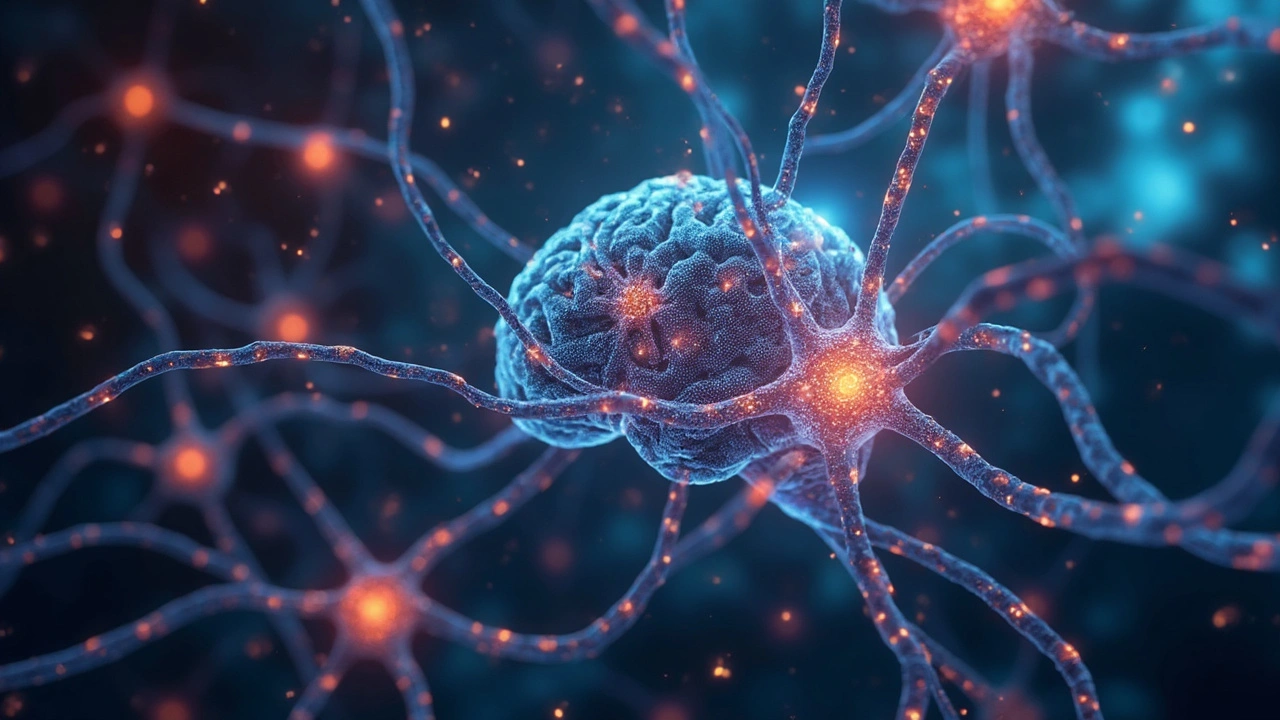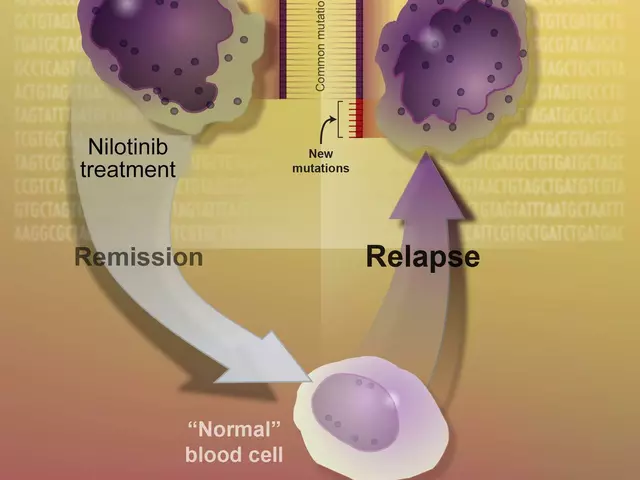
Explore 8 Effective Alternatives to Gabapentin
Let's dive into a topic that's really useful for folks navigating the world of anticonvulsants. We're not just discussing Gabapentin but opening the door to its alternatives. Why? Well, Gabapentin is great for some, but it's not one-size-fits-all. Whether you're dealing with seizures, nerve pain, or mood disorders, having options is like having a toolbox full of solutions. Understanding these alternatives can arm you with the best strategy for your personal health journey.
One of the contenders here is Valproate, known in the market as Depakote. It's a broad-spectrum anticonvulsant, which basically means it's pretty versatile. Working its magic by enhancing GABAergic activity and inhibiting sodium channels, it's been effective for various seizure types, mood stabilization, and even migraine prevention. But like everything, it comes with its pros and cons.
- Valproate (Depakote)
- Pregabalin (Lyrica)
- Carbamazepine (Tegretol)
- Lamotrigine (Lamictal)
- Topiramate (Topamax)
- Levetiracetam (Keppra)
- Oxcarbazepine (Trileptal)
- Zonisamide (Zonegran)
- Conclusion
Valproate (Depakote)
So, you've probably heard about Valproate, also known as Depakote, right? It's quite the multitasker in the world of medications. Primarily, it's a broad-spectrum anticonvulsant, meaning it's designed to tackle various seizure types. But that's not all. It's also used to stabilize mood in people with bipolar disorder and is handy for preventing migraines. Talk about versatility!
Now, let's break down why Valproate could be a go-to alternative to Gabapentin. For starters, if you're struggling with different types of seizures, Valproate offers a more comprehensive solution. Unlike some meds that only target specific types of seizures, Valproate extends its net to cover multiple kinds, giving you peace of mind.
Pros
- It's effective across a range of seizure subtypes, which is huge if you're dealing with more than one kind.
- Known for its mood-stabilizing properties. It's like hitting two birds with one stone if you're also managing bipolar disorder.
- Available in extended-release formulations, which means fewer doses to remember throughout the day. Who doesn't like a simpler regimen?
Cons
- One downside is the risk of hepatotoxicity. Fancy term, but it basically means potential liver trouble if not monitored properly.
- There's also the teratogenic effect. This is crucial for women who are pregnant or planning to be—it could harm an unborn baby.
- Common side effects include weight gain and sometimes hair loss. Definitely something to chat about with the doc if it concerns you.
A look at some generic stats: Valproate’s effectiveness, particularly in mood disorders, is supported by various studies showing significant improvements in mood stabilization for people with bipolar disorder. It’s always fascinating to know that a medication can pack such a punch across different issues.
Pregabalin (Lyrica)
Let's talk about Pregabalin, or as you might know it, Lyrica. It's a standout contender as a Gabapentin alternative, with some unique features. Originally approved for treating nerve pain caused by shingles, diabetic neuropathy, and spinal cord injuries, it's also been tapped for managing epilepsy and fibromyalgia.
Pregabalin works by calming down the brain's hyperactive nerve signals. This seems kind of dull, but when you're dealing with chronic pain or seizures, that's a game-changer. Its action can lead to noticeably less pain and fewer seizures.
Pros
- Effective for several types of pain, especially nerve-related.
- Takes only about a week to notice benefits.
- It's got the FDA's nod for both seizures and some pain disorders.
- Can help improve sleep quality by reducing pain at night.
Cons
- Common side effects include dizziness, sleepiness, and sometimes blurry vision.
- There's potential for weight gain and swelling in your hands and feet.
- Not the go-to option for those needing long-term management without side effects.
- It's considered to have some abuse potential, given its relaxing effects.
Always compare these options to find what fits you best. For some folks, Pregabalin might be just what's needed to cut through the noise of chronic pain or prevent those pesky seizures. But, always chat with your doctor to navigate through the pros and cons and see where Pregabalin stands in your treatment plan.
Carbamazepine (Tegretol)
Alright, folks, let's get into Carbamazepine, more commonly known as Tegretol. If you've got your ear to the ground about Gabapentin alternatives, this name has probably popped up a few times. It's been in the game for quite a while and is primarily used to tackle epilepsy in both kids and adults. What makes it tick? It stabilizes the electrical activity in the brain, making it super helpful for reducing epileptic seizures.
But that's not all. Tegretol is also prescribed for people dealing with bipolar disorder, particularly the manic episodes. This dual utility is pretty sweet if you're juggling between conditions. Oh, and if you've ever experienced that awful nerve pain known as trigeminal neuralgia? Yeah, it can take care of that too.
So, what's great about it?
Pros
- Versatile: Handles a wide range of issues, from epilepsy to bipolar disorder and nerve pain.
- Well-researched: Decades of data back its efficiency, which is reassuring if you're cautious about what you take.
- Long-standing trust: It's been trusted by healthcare professionals for years, which means a lot in the medical world.
However, it's not all sunshine and rainbows.
Cons
- Blood monitoring: Regular checks are needed to watch for potential side effects like liver issues or a decrease in white blood cells.
- Drug interactions: It can mess with the effectiveness of other meds, so a good chat with your doc is a must.
- Side effects: Dizziness, fatigue, and nausea can occur, especially when you're just starting.
In case you’re wondering about the nitty-gritty numbers, here's a quick glimpse at its effectiveness:
| Condition | Success Rate (%) |
|---|---|
| Epilepsy Control | 70-90 |
| Bipolar Disorder | 50-60 |
| Trigeminal Neuralgia Relief | 80-85 |
Knowing all this, if Tegretol seems like a fit, it might be worth discussing with your healthcare provider. The key takeaway? It's all about finding that balance between treating symptoms and managing any side effects that pop up.
Lamotrigine (Lamictal)
Here's a medicine that's made waves for its role in managing epilepsy and bipolar disorder—Lamotrigine (Lamictal). This one belongs to the anticonvulsant drug family and is known for its impact on chemicals in the brain involved in these conditions. But what sets it apart?
Lamotrigine works by stabilizing electrical activity in the brain. It helps prevent mood swings by keeping mood-stabilizing chemicals in balance. It's a lifesaver for many, especially those juggling epilepsy and bipolar disorder since it tackles both issues without needing two separate sets of pills.
Pros
- Great for reducing the frequency and intensity of seizures.
- Effective mood stabilization properties, which is a hit with those managing bipolar disorder.
- Less likely to cause weight gain—a bonus for many compared to other meds.
Cons
- There’s a risk of a severe skin rash, especially when starting the drug or increasing the dose too quickly.
- Common side effects can include dizziness, headaches, and blurred vision.
- Not typically recommended for pregnant women due to potential risks.
Lamotrigine is usually introduced slowly, with doses gradually increased to minimize side effects. In practice, it's helped many people find stability where there was once chaos. However, like with anything, it's crucial to weigh the good against the bad and consult with healthcare providers about what's best for your needs.

Topiramate (Topamax)
When it comes to alternatives to Gabapentin, Topiramate—better known as Topamax—often steps in as a handy option. This medication is a bit of a multitasker. It's mainly used to manage seizures and prevent migraines, but it's also explored for other things like mood disorders and weight loss.
Topiramate works by stabilizing electrical activity in the brain, primarily through eavesdropping on neurotransmitter signals. It's like having a guard on patrol who ensures everything stays calm and orderly. This mechanism makes it effective for a variety of conditions, which is a huge plus if you're juggling multiple issues.
Pros
- Effective for both epilepsy and migraine prevention.
- Can assist in weight management, which is a win for those needing both seizure control and weight support.
- Has mood-stabilizing properties, an added bonus for those grappling with mood disorders.
Cons
- Can cause cognitive side effects, like memory issues or mental fog, which some folks find a bit frustrating.
- May lead to unintended weight loss or appetite changes, which might not be everyone's cup of tea.
- Paresthesia, or tingling sensations, is sometimes reported by users, though it's often mild and manageable.
Here's a little nugget of wisdom: According to a comprehensive study, over 70% of users found Topiramate helpful in reducing the frequency of migraines. This makes it a popular pick for individuals who suffer from both seizures and migraines.
When considering Gabapentin alternatives, knowing the benefits and potential pitfalls of Topiramate helps tailor your approach to what's personally important. It means you can weigh the pros against the cons based on your unique health priorities and lifestyle needs.
Levetiracetam (Keppra)
Alright, let's talk about something quite popular in the world of anticonvulsants: Levetiracetam, better known as Keppra. This one's often prescribed for epilepsy, serving as a go-to for many neurologists. Why is it so favored? Well, it's got a reputation for having fewer interactions with other medications, which can be a big win, especially for folks juggling pills like they're multivitamins.
Keppra works by affecting the transmission of nerve signals in the brain, but its exact mechanism isn't fully understood. This might sound a bit mysterious, but it's effective at managing partial, myoclonic, and primary generalized tonic-clonic seizures. Plus, it's available for both adults and children, which makes it pretty versatile.
Pros
- Minimal interaction with other drugs — you don't have to worry much if you're taking other stuff.
- Widely used for different seizure types, so it's quite flexible.
- Available in various forms like tablets, liquid, and even injection.
Cons
- Behavioral side effects like mood swings can occur in some folks.
- Fatigue and dizziness are fairly common complaints.
- Some users report irritability and coordination issues.
Now, there's a relatable stat for you: about 30% of people with epilepsy find Keppra effective as a monotherapy. That's a decent chunk, right? But remember, like all meds, it's best to chat with a healthcare professional to see if it's the right fit for you. Because at the end of the day, finding the right med can be a bit like dating—sometimes you gotta kiss a few frogs.
Oxcarbazepine (Trileptal)
When it comes to finding alternatives, Oxcarbazepine (Trileptal) is often in the spotlight. This medication is primarily used for managing partial seizures and can be a game-changer for those who experience adverse effects with other meds. Oxcarbazepine works by blocking sodium channels in the brain, which helps stabilize nerve activity. It's kind of like setting the volume just right so the music plays smoothly.
One big plus is that Oxcarbazepine usually causes fewer interactions with other medications. For many, that's a huge relief. If you're someone who takes multiple prescriptions, reducing drug interactions is like having one less worry on your plate. It's also known for a smoother side effect profile compared to some of its competitors.
Pros
- Reduced risk of drug interactions, making it easier to pair with other treatments.
- Usually tolerated better by folks sensitive to other medications.
- Effective in controlling partial seizures.
Cons
- Potential side effects include dizziness and fatigue, something to keep in mind if you're often on the go.
- Hyponatremia, or low sodium, is a possible risk, so regular monitoring is advised.
In a survey of patients using Oxcarbazepine, many reported a significant reduction in seizure frequency, often describing it as allowing them to take back some control of their day-to-day lives. That's a pretty big deal when dealing with seizures. Whether it's shopping for groceries or just meeting a friend for coffee, consistency is key.
Choosing the right medication can feel daunting, but with a bit of knowledge, making an informed decision becomes a whole lot easier. Whether Oxcarbazepine fits the bill for you can depend on various factors, but having it as an option is undoubtedly a step in the right direction.
Zonisamide (Zonegran)
When it comes to exploring alternatives to Gabapentin, Zonisamide could be your next stop. Sold under the brand name Zonegran, this medication is another player in the anticonvulsant league. Specifically used for the treatment of partial seizures in adults, it acts by stabilizing neuronal activity. How does it do that? By blocking sodium and calcium channels, which helps dampen seizure-inducing neuronal discharges.
So, what are the highlights of Zonegran? It's not only effective for adult seizures but also sometimes prescribed off-label for other conditions. Some say it might even help in weight management—a rare perk when many anticonvulsants can make you pack on the pounds. And it's got a long half-life, meaning you don’t need to pop it as frequently.
Pros
- Effective for partial seizures: Designed primarily for managing seizures in adults.
- Potential for weight loss: Compared to others, it might help in shedding a few pounds.
- Long half-life: Less frequent dosing is needed, which can be super convenient.
Cons
- Kidney stone risk: It increases the likelihood of developing kidney stones, so stay hydrated.
- Cognitive effects: Some users might experience challenges in focusing or memory issues.
- Hypersensitivity reactions: There's a risk of serious skin reactions for those allergic to sulfa drugs.
One fun fact? A study reported that Zonisamide helped reduce binge-eating episodes in certain individuals, although it's not officially approved for that use. Remember, because it contains a sulfa molecule, it’s not the best choice if you’ve got a sulfa allergy. Also, drink plenty of water to dodge those pesky kidney stones.

Conclusion
Navigating the landscape of Gabapentin alternatives can feel like decoding a complex map, but having these key players makes the journey smoother. Each option offers its flavor of benefits, whether it's Valproate's broad-spectrum efficacy or Carbamazepine's focus on specific seizure types and mood swings.
If your main focus is addressing multiple seizure disorders along with mood stabilization, Valproate (Depakote) might be your go-to. With its knack for covering various seizure types and providing mood stabilization, it’s a powerful pick. However, weigh the risk of hepatotoxicity and potential weight changes.
Alternatively, Pregabalin (Lyrica) offers more specialized relief for nerve pain, especially for patients who need support beyond anticonvulsant use. Look into its benefits if nerve pain management is at the forefront for you.
For those balancing epilepsy with mental health challenges, Lamotrigine (Lamictal) and Topiramate (Topamax) provide promising options. Each has unique properties that make them ideal for managing symptoms that overlap between neurological and psychological realms.
Here's a quick look at how these alternatives stack up in various areas:
| Medication | Primary Use | Pros | Cons |
|---|---|---|---|
| Valproate (Depakote) | Seizures, Bipolar Disorder | Versatile, Mood-Stabilizing | Hepatotoxicity Risk |
| Pregabalin (Lyrica) | Nerve Pain, Anxiety | Effective for Neuropathic Pain | Weight Gain, Drowsiness |
| Lamotrigine (Lamictal) | Epilepsy, Bipolar Disorder | Good for Mood Disorders | Skin Rash Risk |
Remember, your choice of medication should always be a joint decision with a healthcare provider. Together, you can weigh these alternatives to Gabapentin, ensuring your health strategy aligns with your personal needs and circumstances. Always consider your unique health profile and the specific nuances of each treatment option. It's all about finding the right balance and what works best for your situation.





Written by Jakob Fitzroy
My name is Jakob Fitzroy, and I am an expert in pharmaceuticals with a passion for writing. I have dedicated my life to studying medication and understanding how it affects various diseases. My goal is to educate people about the importance of proper drug therapy and prevention methods. I have authored numerous articles, providing valuable insights on medication, its development, and its impact on patients. My driving force is to contribute to the ongoing fight against diseases and improve the overall health and well-being of people around the world.
All posts: Jakob Fitzroy